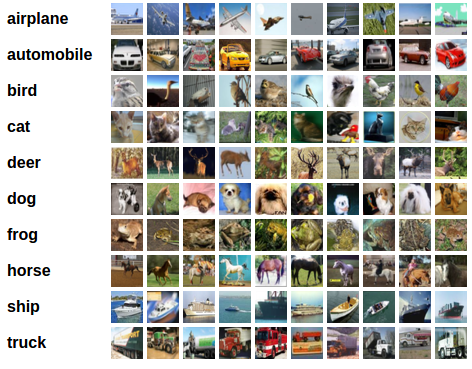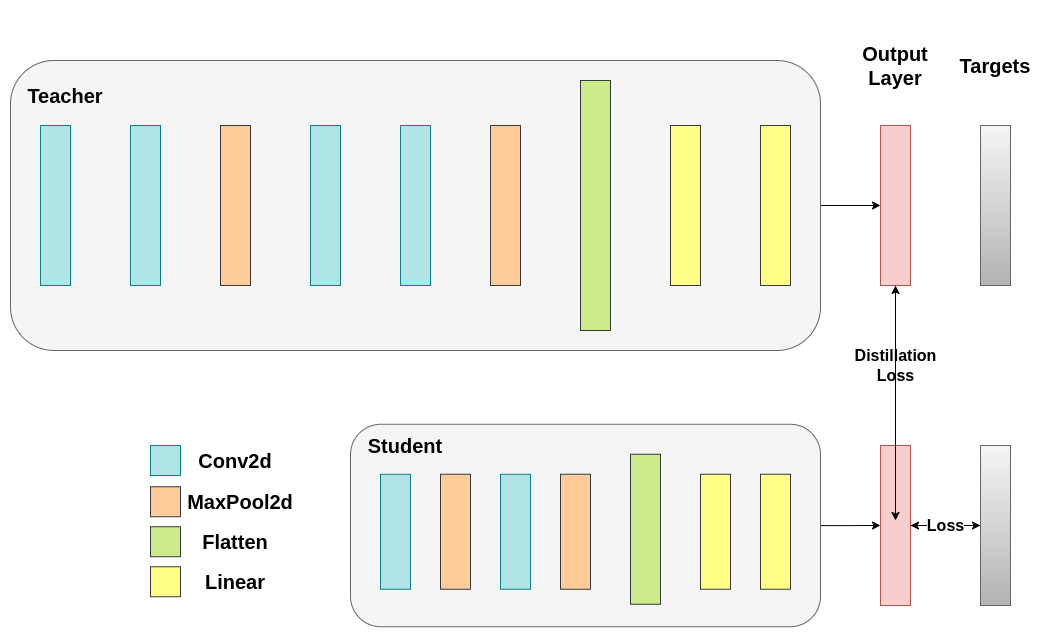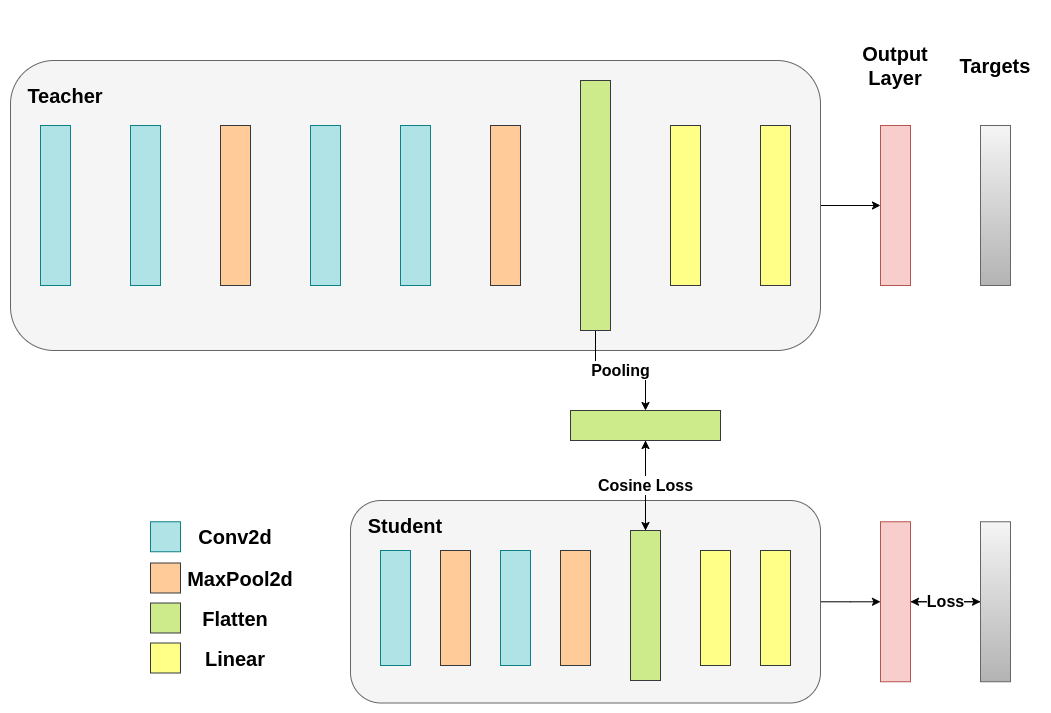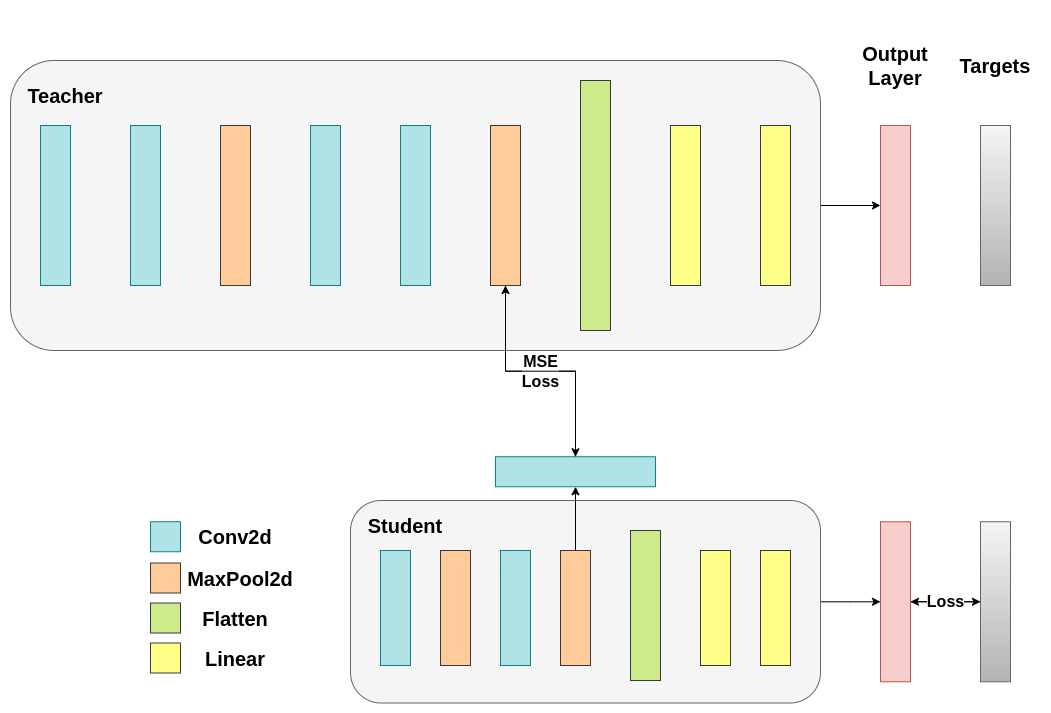


注意
转到末尾 下载完整的示例代码。
知识蒸馏教程#
创建日期:2023年8月22日 | 最后更新:2025年1月24日 | 最后验证:2024年11月05日
知识蒸馏是一种技术,它能够将知识从大型、计算成本高昂的模型转移到小型模型,同时不损失有效性。这使得模型可以在能力较弱的硬件上部署,从而使评估更快、更有效。
在本教程中,我们将进行一系列实验,重点是提高轻量级神经网络的准确性,使用一个更强大的网络作为教师。轻量级网络的计算成本和速度将保持不变,我们的干预仅关注其权重,而不是其前向传播。这项技术的应用可以在无人机或手机等设备上找到。在本教程中,我们不使用任何外部包,因为我们需要的所有内容都可以在 torch 和 torchvision 中找到。
在本教程中,您将学到
如何修改模型类以提取隐藏表示并用于进一步计算
如何修改 PyTorch 中的常规训练循环,在分类的交叉熵等损失之上添加额外的损失
如何通过使用更复杂的模型作为教师来提高轻量级模型的性能
先决条件#
1 块 GPU,4GB 内存
PyTorch v2.0 或更高版本
CIFAR-10 数据集(由脚本下载并保存在名为
/data的目录中)
import torch
import torch.nn as nn
import torch.optim as optim
import torchvision.transforms as transforms
import torchvision.datasets as datasets
# Check if the current `accelerator <https://pytorch.ac.cn/docs/stable/torch.html#accelerators>`__
# is available, and if not, use the CPU
device = torch.accelerator.current_accelerator().type if torch.accelerator.is_available() else "cpu"
print(f"Using {device} device")
Using cuda device
加载 CIFAR-10#
CIFAR-10 是一个流行的图像数据集,包含十个类别。我们的目标是为每个输入图像预测以下类别之一。

CIFAR-10 图像示例#
输入图像是 RGB,因此它们有 3 个通道,大小为 32x32 像素。基本上,每张图像由 3 x 32 x 32 = 3072 个数字组成,范围从 0 到 255。在神经网络中,对输入进行归一化是一种常见做法,原因有多种,包括避免常用激活函数的饱和和提高数值稳定性。我们的归一化过程包括减去每个通道的平均值并除以标准差。张量 “mean=[0.485, 0.456, 0.406]” 和 “std=[0.229, 0.224, 0.225]” 已经计算得出,它们代表了预定义 CIFAR-10 子集中每个通道的平均值和标准差,该子集旨在作为训练集。请注意,我们也对测试集使用了这些值,而没有从头开始重新计算平均值和标准差。这是因为网络是在减去和除以上述数字后产生的特征上训练的,我们希望保持一致性。此外,在现实生活中,我们无法计算测试集的平均值和标准差,因为根据我们的假设,此时该数据将无法访问。
最后一点,我们通常将这个未使用的集合称为验证集,在优化模型在验证集上的性能后,我们会使用一个单独的集合,称为测试集。这样做是为了避免基于对单个指标的贪婪和有偏优化的模型进行选择。
# Below we are preprocessing data for CIFAR-10. We use an arbitrary batch size of 128.
transforms_cifar = transforms.Compose([
transforms.ToTensor(),
transforms.Normalize(mean=[0.485, 0.456, 0.406], std=[0.229, 0.224, 0.225]),
])
# Loading the CIFAR-10 dataset:
train_dataset = datasets.CIFAR10(root='./data', train=True, download=True, transform=transforms_cifar)
test_dataset = datasets.CIFAR10(root='./data', train=False, download=True, transform=transforms_cifar)
0%| | 0.00/170M [00:00<?, ?B/s]
0%| | 590k/170M [00:00<00:28, 5.88MB/s]
4%|▍ | 7.18M/170M [00:00<00:03, 41.0MB/s]
10%|▉ | 16.4M/170M [00:00<00:02, 63.9MB/s]
15%|█▌ | 25.6M/170M [00:00<00:01, 75.1MB/s]
19%|█▉ | 33.2M/170M [00:00<00:01, 71.5MB/s]
26%|██▌ | 44.4M/170M [00:00<00:01, 84.5MB/s]
31%|███▏ | 53.6M/170M [00:00<00:01, 86.9MB/s]
38%|███▊ | 64.2M/170M [00:00<00:01, 92.5MB/s]
43%|████▎ | 73.6M/170M [00:00<00:01, 93.0MB/s]
49%|████▊ | 82.9M/170M [00:01<00:00, 93.0MB/s]
54%|█████▍ | 92.3M/170M [00:01<00:00, 84.2MB/s]
59%|█████▉ | 101M/170M [00:01<00:00, 83.2MB/s]
64%|██████▍ | 109M/170M [00:01<00:00, 82.5MB/s]
69%|██████▉ | 118M/170M [00:01<00:00, 79.9MB/s]
74%|███████▍ | 126M/170M [00:01<00:00, 81.2MB/s]
79%|███████▉ | 135M/170M [00:01<00:00, 82.6MB/s]
85%|████████▍ | 145M/170M [00:01<00:00, 87.4MB/s]
90%|█████████ | 154M/170M [00:01<00:00, 76.9MB/s]
95%|█████████▍| 162M/170M [00:02<00:00, 74.9MB/s]
99%|█████████▉| 169M/170M [00:02<00:00, 74.0MB/s]
100%|██████████| 170M/170M [00:02<00:00, 78.7MB/s]
注意
此部分仅适用于对快速结果感兴趣的 CPU 用户。仅当您对小规模实验感兴趣时才使用此选项。请记住,代码应该使用任何 GPU 快速运行。仅从训练/测试数据集中选择前 num_images_to_keep 张图像
#from torch.utils.data import Subset
#num_images_to_keep = 2000
#train_dataset = Subset(train_dataset, range(min(num_images_to_keep, 50_000)))
#test_dataset = Subset(test_dataset, range(min(num_images_to_keep, 10_000)))
#Dataloaders
train_loader = torch.utils.data.DataLoader(train_dataset, batch_size=128, shuffle=True, num_workers=2)
test_loader = torch.utils.data.DataLoader(test_dataset, batch_size=128, shuffle=False, num_workers=2)
定义模型类和实用函数#
接下来,我们需要定义我们的模型类。这里需要设置几个用户定义的参数。我们使用两种不同的架构,在我们的实验中保持滤波器数量固定,以确保公平比较。这两种架构都是卷积神经网络 (CNN),具有不同数量的卷积层作为特征提取器,然后是一个具有 10 个类别的分类器。学生模型的滤波器和神经元数量较少。
# Deeper neural network class to be used as teacher:
class DeepNN(nn.Module):
def __init__(self, num_classes=10):
super(DeepNN, self).__init__()
self.features = nn.Sequential(
nn.Conv2d(3, 128, kernel_size=3, padding=1),
nn.ReLU(),
nn.Conv2d(128, 64, kernel_size=3, padding=1),
nn.ReLU(),
nn.MaxPool2d(kernel_size=2, stride=2),
nn.Conv2d(64, 64, kernel_size=3, padding=1),
nn.ReLU(),
nn.Conv2d(64, 32, kernel_size=3, padding=1),
nn.ReLU(),
nn.MaxPool2d(kernel_size=2, stride=2),
)
self.classifier = nn.Sequential(
nn.Linear(2048, 512),
nn.ReLU(),
nn.Dropout(0.1),
nn.Linear(512, num_classes)
)
def forward(self, x):
x = self.features(x)
x = torch.flatten(x, 1)
x = self.classifier(x)
return x
# Lightweight neural network class to be used as student:
class LightNN(nn.Module):
def __init__(self, num_classes=10):
super(LightNN, self).__init__()
self.features = nn.Sequential(
nn.Conv2d(3, 16, kernel_size=3, padding=1),
nn.ReLU(),
nn.MaxPool2d(kernel_size=2, stride=2),
nn.Conv2d(16, 16, kernel_size=3, padding=1),
nn.ReLU(),
nn.MaxPool2d(kernel_size=2, stride=2),
)
self.classifier = nn.Sequential(
nn.Linear(1024, 256),
nn.ReLU(),
nn.Dropout(0.1),
nn.Linear(256, num_classes)
)
def forward(self, x):
x = self.features(x)
x = torch.flatten(x, 1)
x = self.classifier(x)
return x
我们使用 2 个函数来帮助我们在原始分类任务上生成和评估结果。一个函数称为 train,它接受以下参数:
model:一个通过此函数训练(更新权重)的模型实例。train_loader:我们上面定义了train_loader,它的作用是将数据输入模型。epochs:我们遍历数据集的次数。learning_rate:学习率决定了我们走向收敛的步长有多大。过大或过小的步长都可能有害。device:确定运行工作负载的设备。根据可用性,可以是 CPU 或 GPU。
我们的测试函数类似,但它将使用 test_loader 来加载测试集中的图像。

使用交叉熵训练两个网络。学生模型将用作基线:#
def train(model, train_loader, epochs, learning_rate, device):
criterion = nn.CrossEntropyLoss()
optimizer = optim.Adam(model.parameters(), lr=learning_rate)
model.train()
for epoch in range(epochs):
running_loss = 0.0
for inputs, labels in train_loader:
# inputs: A collection of batch_size images
# labels: A vector of dimensionality batch_size with integers denoting class of each image
inputs, labels = inputs.to(device), labels.to(device)
optimizer.zero_grad()
outputs = model(inputs)
# outputs: Output of the network for the collection of images. A tensor of dimensionality batch_size x num_classes
# labels: The actual labels of the images. Vector of dimensionality batch_size
loss = criterion(outputs, labels)
loss.backward()
optimizer.step()
running_loss += loss.item()
print(f"Epoch {epoch+1}/{epochs}, Loss: {running_loss / len(train_loader)}")
def test(model, test_loader, device):
model.to(device)
model.eval()
correct = 0
total = 0
with torch.no_grad():
for inputs, labels in test_loader:
inputs, labels = inputs.to(device), labels.to(device)
outputs = model(inputs)
_, predicted = torch.max(outputs.data, 1)
total += labels.size(0)
correct += (predicted == labels).sum().item()
accuracy = 100 * correct / total
print(f"Test Accuracy: {accuracy:.2f}%")
return accuracy
交叉熵运行#
为了可重现性,我们需要设置 torch 的手动种子。我们使用不同的方法训练网络,因此为了公平比较,用相同的权重初始化网络是有意义的。首先,使用交叉熵训练教师网络
torch.manual_seed(42)
nn_deep = DeepNN(num_classes=10).to(device)
train(nn_deep, train_loader, epochs=10, learning_rate=0.001, device=device)
test_accuracy_deep = test(nn_deep, test_loader, device)
# Instantiate the lightweight network:
torch.manual_seed(42)
nn_light = LightNN(num_classes=10).to(device)
Epoch 1/10, Loss: 1.3380480573305389
Epoch 2/10, Loss: 0.8689962590441984
Epoch 3/10, Loss: 0.6735104577773062
Epoch 4/10, Loss: 0.5305723712572357
Epoch 5/10, Loss: 0.4093079611163615
Epoch 6/10, Loss: 0.300734175593042
Epoch 7/10, Loss: 0.21761560725891377
Epoch 8/10, Loss: 0.1718607815959112
Epoch 9/10, Loss: 0.13632688448404717
Epoch 10/10, Loss: 0.11418102288147068
Test Accuracy: 74.84%
我们实例化了一个额外的轻量级网络模型来比较它们的性能。反向传播对权重初始化很敏感,因此我们需要确保这两个网络具有完全相同的初始化。
torch.manual_seed(42)
new_nn_light = LightNN(num_classes=10).to(device)
为确保我们创建了第一个网络的副本,我们检查了其第一层的范数。如果匹配,我们可以安全地得出结论,这两个网络确实是相同的。
# Print the norm of the first layer of the initial lightweight model
print("Norm of 1st layer of nn_light:", torch.norm(nn_light.features[0].weight).item())
# Print the norm of the first layer of the new lightweight model
print("Norm of 1st layer of new_nn_light:", torch.norm(new_nn_light.features[0].weight).item())
Norm of 1st layer of nn_light: 2.327361822128296
Norm of 1st layer of new_nn_light: 2.327361822128296
打印每个模型中的总参数数量
total_params_deep = "{:,}".format(sum(p.numel() for p in nn_deep.parameters()))
print(f"DeepNN parameters: {total_params_deep}")
total_params_light = "{:,}".format(sum(p.numel() for p in nn_light.parameters()))
print(f"LightNN parameters: {total_params_light}")
DeepNN parameters: 1,186,986
LightNN parameters: 267,738
使用交叉熵损失训练和测试轻量级网络
train(nn_light, train_loader, epochs=10, learning_rate=0.001, device=device)
test_accuracy_light_ce = test(nn_light, test_loader, device)
Epoch 1/10, Loss: 1.4703684837921807
Epoch 2/10, Loss: 1.1607250258745745
Epoch 3/10, Loss: 1.031156221161718
Epoch 4/10, Loss: 0.931552555554968
Epoch 5/10, Loss: 0.8572665924001532
Epoch 6/10, Loss: 0.7909330646400257
Epoch 7/10, Loss: 0.7265385107311142
Epoch 8/10, Loss: 0.6723965189188642
Epoch 9/10, Loss: 0.6193338737768286
Epoch 10/10, Loss: 0.5720619233825323
Test Accuracy: 70.17%
正如我们所见,基于测试准确性,我们现在可以比较将用作教师的深度网络和我们假定的学生的轻量级网络。到目前为止,我们的学生没有干预教师,因此这种性能是学生本身实现的。到目前为止的指标可以通过以下几行看到:
print(f"Teacher accuracy: {test_accuracy_deep:.2f}%")
print(f"Student accuracy: {test_accuracy_light_ce:.2f}%")
Teacher accuracy: 74.84%
Student accuracy: 70.17%
知识蒸馏运行#
现在让我们尝试通过引入教师来提高学生网络的测试准确性。知识蒸馏是一种简单易行的技术来实现这一目标,基于这样一个事实:两个网络都输出我们类别的概率分布。因此,两个网络共享相同数量的输出神经元。该方法通过在传统的交叉熵损失中添加一个额外的损失来实现,该损失基于教师网络的 softmax 输出。假设一个经过适当训练的教师网络的输出激活携带了额外信息,学生网络在训练过程中可以利用这些信息。最初的工作表明,利用软目标中较小概率的比例有助于实现深度神经网络的根本目标,即在数据上创建相似性结构,使相似的对象映射得更近。例如,在 CIFAR-10 中,一辆卡车如果带有轮子,可能会被误认为是汽车或飞机,但不太可能被误认为是狗。因此,假设有价值的信息不仅存在于经过适当训练的模型的顶级预测中,还存在于整个输出分布中,这是有道理的。然而,仅靠交叉熵不足以充分利用这些信息,因为非预测类别的激活往往非常小,以至于传播的梯度不会有意义地改变权重来构建这种理想的向量空间。
在我们继续定义第一个引入教师-学生动态的辅助函数时,我们需要包含一些额外的参数:
T:温度控制输出分布的平滑度。较高的T会导致更平滑的分布,从而使较小的概率获得更大的提升。soft_target_loss_weight:分配给我们即将包含的额外目标的权重。ce_loss_weight:分配给交叉熵的权重。调整这些权重会促使网络优先优化其中一个目标。

蒸馏损失从网络的 logits 计算得出。它只将梯度返回给学生:#
def train_knowledge_distillation(teacher, student, train_loader, epochs, learning_rate, T, soft_target_loss_weight, ce_loss_weight, device):
ce_loss = nn.CrossEntropyLoss()
optimizer = optim.Adam(student.parameters(), lr=learning_rate)
teacher.eval() # Teacher set to evaluation mode
student.train() # Student to train mode
for epoch in range(epochs):
running_loss = 0.0
for inputs, labels in train_loader:
inputs, labels = inputs.to(device), labels.to(device)
optimizer.zero_grad()
# Forward pass with the teacher model - do not save gradients here as we do not change the teacher's weights
with torch.no_grad():
teacher_logits = teacher(inputs)
# Forward pass with the student model
student_logits = student(inputs)
#Soften the student logits by applying softmax first and log() second
soft_targets = nn.functional.softmax(teacher_logits / T, dim=-1)
soft_prob = nn.functional.log_softmax(student_logits / T, dim=-1)
# Calculate the soft targets loss. Scaled by T**2 as suggested by the authors of the paper "Distilling the knowledge in a neural network"
soft_targets_loss = torch.sum(soft_targets * (soft_targets.log() - soft_prob)) / soft_prob.size()[0] * (T**2)
# Calculate the true label loss
label_loss = ce_loss(student_logits, labels)
# Weighted sum of the two losses
loss = soft_target_loss_weight * soft_targets_loss + ce_loss_weight * label_loss
loss.backward()
optimizer.step()
running_loss += loss.item()
print(f"Epoch {epoch+1}/{epochs}, Loss: {running_loss / len(train_loader)}")
# Apply ``train_knowledge_distillation`` with a temperature of 2. Arbitrarily set the weights to 0.75 for CE and 0.25 for distillation loss.
train_knowledge_distillation(teacher=nn_deep, student=new_nn_light, train_loader=train_loader, epochs=10, learning_rate=0.001, T=2, soft_target_loss_weight=0.25, ce_loss_weight=0.75, device=device)
test_accuracy_light_ce_and_kd = test(new_nn_light, test_loader, device)
# Compare the student test accuracy with and without the teacher, after distillation
print(f"Teacher accuracy: {test_accuracy_deep:.2f}%")
print(f"Student accuracy without teacher: {test_accuracy_light_ce:.2f}%")
print(f"Student accuracy with CE + KD: {test_accuracy_light_ce_and_kd:.2f}%")
Epoch 1/10, Loss: 2.420701376007646
Epoch 2/10, Loss: 1.9034097984318843
Epoch 3/10, Loss: 1.6752258091021681
Epoch 4/10, Loss: 1.5147676419114213
Epoch 5/10, Loss: 1.3861400674066275
Epoch 6/10, Loss: 1.267950757385215
Epoch 7/10, Loss: 1.1739736123158193
Epoch 8/10, Loss: 1.092016106218938
Epoch 9/10, Loss: 1.0159087505791804
Epoch 10/10, Loss: 0.9451471789718588
Test Accuracy: 71.00%
Teacher accuracy: 74.84%
Student accuracy without teacher: 70.17%
Student accuracy with CE + KD: 71.00%
余弦损失最小化运行#
您可以随意调整控制 softmax 函数平滑度的温度参数和损失系数。在神经网络中,很容易在主要目标中添加额外的损失函数来实现更好的泛化等目标。让我们尝试为学生模型添加一个目标,但现在我们关注它们的隐藏状态而不是输出层。我们的目标是通过包含一个朴素的损失函数,将信息从教师的表示传递给学生,该损失函数的最小化意味着扁平化的向量随后传递给分类器,随着损失的降低,这些向量变得更加“相似”。当然,教师不会更新其权重,因此最小化仅取决于学生的权重。这种方法的原理是我们假设教师模型具有更好的内部表示,学生模型在没有外部干预的情况下不太可能达到这种表示,因此我们人为地推动学生模仿教师的内部表示。但这是否最终会帮助学生模型并不直接,因为推动轻量级网络达到这一点可能是一件好事,假设我们找到了一个能带来更好测试准确性的内部表示,但也可能是有害的,因为网络具有不同的架构,学生模型的学习能力不如教师模型。换句话说,这两个向量(学生和教师的)没有理由在每个分量上都匹配。学生模型可以达到一个与教师模型表示相置换的内部表示,并且同样有效。尽管如此,我们仍然可以进行快速实验来弄清楚这种方法的影响。我们将使用 CosineEmbeddingLoss,其公式如下:

CosineEmbeddingLoss 公式#
显然,有一件事需要我们先解决。当我们对输出层进行蒸馏时,我们提到两个网络具有相同数量的神经元,等于类别的数量。然而,这对于我们卷积层之后的层来说并非如此。在这里,在展平最后一个卷积层后,教师拥有的神经元比学生多。我们的损失函数接受两个维度相同的向量作为输入,因此我们需要以某种方式匹配它们。我们将通过在教师的卷积层之后包含一个平均池化层来解决这个问题,以减小其维度以匹配学生的维度。
为了继续,我们将修改我们的模型类,或者创建新的类。现在,forward 函数不仅返回网络的 logits,还返回卷积层之后的扁平化隐藏表示。我们包含了对修改后的教师的上述池化。
class ModifiedDeepNNCosine(nn.Module):
def __init__(self, num_classes=10):
super(ModifiedDeepNNCosine, self).__init__()
self.features = nn.Sequential(
nn.Conv2d(3, 128, kernel_size=3, padding=1),
nn.ReLU(),
nn.Conv2d(128, 64, kernel_size=3, padding=1),
nn.ReLU(),
nn.MaxPool2d(kernel_size=2, stride=2),
nn.Conv2d(64, 64, kernel_size=3, padding=1),
nn.ReLU(),
nn.Conv2d(64, 32, kernel_size=3, padding=1),
nn.ReLU(),
nn.MaxPool2d(kernel_size=2, stride=2),
)
self.classifier = nn.Sequential(
nn.Linear(2048, 512),
nn.ReLU(),
nn.Dropout(0.1),
nn.Linear(512, num_classes)
)
def forward(self, x):
x = self.features(x)
flattened_conv_output = torch.flatten(x, 1)
x = self.classifier(flattened_conv_output)
flattened_conv_output_after_pooling = torch.nn.functional.avg_pool1d(flattened_conv_output, 2)
return x, flattened_conv_output_after_pooling
# Create a similar student class where we return a tuple. We do not apply pooling after flattening.
class ModifiedLightNNCosine(nn.Module):
def __init__(self, num_classes=10):
super(ModifiedLightNNCosine, self).__init__()
self.features = nn.Sequential(
nn.Conv2d(3, 16, kernel_size=3, padding=1),
nn.ReLU(),
nn.MaxPool2d(kernel_size=2, stride=2),
nn.Conv2d(16, 16, kernel_size=3, padding=1),
nn.ReLU(),
nn.MaxPool2d(kernel_size=2, stride=2),
)
self.classifier = nn.Sequential(
nn.Linear(1024, 256),
nn.ReLU(),
nn.Dropout(0.1),
nn.Linear(256, num_classes)
)
def forward(self, x):
x = self.features(x)
flattened_conv_output = torch.flatten(x, 1)
x = self.classifier(flattened_conv_output)
return x, flattened_conv_output
# We do not have to train the modified deep network from scratch of course, we just load its weights from the trained instance
modified_nn_deep = ModifiedDeepNNCosine(num_classes=10).to(device)
modified_nn_deep.load_state_dict(nn_deep.state_dict())
# Once again ensure the norm of the first layer is the same for both networks
print("Norm of 1st layer for deep_nn:", torch.norm(nn_deep.features[0].weight).item())
print("Norm of 1st layer for modified_deep_nn:", torch.norm(modified_nn_deep.features[0].weight).item())
# Initialize a modified lightweight network with the same seed as our other lightweight instances. This will be trained from scratch to examine the effectiveness of cosine loss minimization.
torch.manual_seed(42)
modified_nn_light = ModifiedLightNNCosine(num_classes=10).to(device)
print("Norm of 1st layer:", torch.norm(modified_nn_light.features[0].weight).item())
Norm of 1st layer for deep_nn: 7.468933582305908
Norm of 1st layer for modified_deep_nn: 7.468933582305908
Norm of 1st layer: 2.327361822128296
自然,我们需要为此更改训练循环,因为现在模型返回一个元组 (logits, hidden_representation)。使用样本输入张量,我们可以打印它们的形状。
# Create a sample input tensor
sample_input = torch.randn(128, 3, 32, 32).to(device) # Batch size: 128, Filters: 3, Image size: 32x32
# Pass the input through the student
logits, hidden_representation = modified_nn_light(sample_input)
# Print the shapes of the tensors
print("Student logits shape:", logits.shape) # batch_size x total_classes
print("Student hidden representation shape:", hidden_representation.shape) # batch_size x hidden_representation_size
# Pass the input through the teacher
logits, hidden_representation = modified_nn_deep(sample_input)
# Print the shapes of the tensors
print("Teacher logits shape:", logits.shape) # batch_size x total_classes
print("Teacher hidden representation shape:", hidden_representation.shape) # batch_size x hidden_representation_size
Student logits shape: torch.Size([128, 10])
Student hidden representation shape: torch.Size([128, 1024])
Teacher logits shape: torch.Size([128, 10])
Teacher hidden representation shape: torch.Size([128, 1024])
在我们的例子中,hidden_representation_size 是 1024。这是学生模型的最后一个卷积层的扁平化特征图,正如您所见,它是其分类器的输入。对于教师模型,它也是 1024,因为我们通过 avg_pool1d 从 2048 进行了设置。这里应用的损失仅影响学生模型在损失计算之前的权重。换句话说,它不影响学生模型的分类器。修改后的训练循环如下:

在余弦损失最小化中,我们希望通过将梯度返回给学生来最大化两个表示的余弦相似度:#
def train_cosine_loss(teacher, student, train_loader, epochs, learning_rate, hidden_rep_loss_weight, ce_loss_weight, device):
ce_loss = nn.CrossEntropyLoss()
cosine_loss = nn.CosineEmbeddingLoss()
optimizer = optim.Adam(student.parameters(), lr=learning_rate)
teacher.to(device)
student.to(device)
teacher.eval() # Teacher set to evaluation mode
student.train() # Student to train mode
for epoch in range(epochs):
running_loss = 0.0
for inputs, labels in train_loader:
inputs, labels = inputs.to(device), labels.to(device)
optimizer.zero_grad()
# Forward pass with the teacher model and keep only the hidden representation
with torch.no_grad():
_, teacher_hidden_representation = teacher(inputs)
# Forward pass with the student model
student_logits, student_hidden_representation = student(inputs)
# Calculate the cosine loss. Target is a vector of ones. From the loss formula above we can see that is the case where loss minimization leads to cosine similarity increase.
hidden_rep_loss = cosine_loss(student_hidden_representation, teacher_hidden_representation, target=torch.ones(inputs.size(0)).to(device))
# Calculate the true label loss
label_loss = ce_loss(student_logits, labels)
# Weighted sum of the two losses
loss = hidden_rep_loss_weight * hidden_rep_loss + ce_loss_weight * label_loss
loss.backward()
optimizer.step()
running_loss += loss.item()
print(f"Epoch {epoch+1}/{epochs}, Loss: {running_loss / len(train_loader)}")
出于相同的原因,我们需要修改我们的测试函数。这里我们忽略模型返回的隐藏表示。
def test_multiple_outputs(model, test_loader, device):
model.to(device)
model.eval()
correct = 0
total = 0
with torch.no_grad():
for inputs, labels in test_loader:
inputs, labels = inputs.to(device), labels.to(device)
outputs, _ = model(inputs) # Disregard the second tensor of the tuple
_, predicted = torch.max(outputs.data, 1)
total += labels.size(0)
correct += (predicted == labels).sum().item()
accuracy = 100 * correct / total
print(f"Test Accuracy: {accuracy:.2f}%")
return accuracy
在这种情况下,我们可以轻松地将知识蒸馏和余弦损失最小化都包含在一个函数中。通常会结合使用多种方法来实现教师-学生范式中的更好性能。目前,我们可以运行一个简单的训练-测试会话。
# Train and test the lightweight network with cross entropy loss
train_cosine_loss(teacher=modified_nn_deep, student=modified_nn_light, train_loader=train_loader, epochs=10, learning_rate=0.001, hidden_rep_loss_weight=0.25, ce_loss_weight=0.75, device=device)
test_accuracy_light_ce_and_cosine_loss = test_multiple_outputs(modified_nn_light, test_loader, device)
Epoch 1/10, Loss: 1.3003839559262367
Epoch 2/10, Loss: 1.0687231790379186
Epoch 3/10, Loss: 0.9705146174601582
Epoch 4/10, Loss: 0.8942109386024573
Epoch 5/10, Loss: 0.8398711993871137
Epoch 6/10, Loss: 0.7960785875844834
Epoch 7/10, Loss: 0.7546686552979452
Epoch 8/10, Loss: 0.7190434603435
Epoch 9/10, Loss: 0.6790954071237608
Epoch 10/10, Loss: 0.6566963798707098
Test Accuracy: 70.60%
中间回归器运行#
我们的朴素最小化不能保证更好的结果,原因有几个,其中之一是向量的维度。对于更高维度的向量,余弦相似度通常比欧几里得距离效果更好,但我们处理的是每个向量有 1024 个分量,因此提取有意义的相似度要困难得多。此外,正如我们提到的,推动匹配教师和学生的隐藏表示不受理论支持。我们没有充分的理由去追求这些向量的一对一匹配。我们将通过引入一个名为回归器的额外网络来提供一个最终的训练干预示例。目标是首先提取教师在卷积层之后的特征图,然后提取学生在卷积层之后的特征图,最后尝试匹配这些图。然而,这次,我们将在网络之间引入一个回归器来促进匹配过程。回归器是可训练的,并且理想情况下会比我们的朴素余弦损失最小化方案做得更好。它的主要工作是匹配这些特征图的维度,以便我们可以正确地定义教师和学生之间的损失函数。定义这样一个损失函数提供了一个教学“路径”,这基本上是一个用于反向传播梯度以改变学生权重的流。关注我们原始网络分类器之前的卷积层的输出,我们有以下形状:
# Pass the sample input only from the convolutional feature extractor
convolutional_fe_output_student = nn_light.features(sample_input)
convolutional_fe_output_teacher = nn_deep.features(sample_input)
# Print their shapes
print("Student's feature extractor output shape: ", convolutional_fe_output_student.shape)
print("Teacher's feature extractor output shape: ", convolutional_fe_output_teacher.shape)
Student's feature extractor output shape: torch.Size([128, 16, 8, 8])
Teacher's feature extractor output shape: torch.Size([128, 32, 8, 8])
教师有 32 个滤波器,学生有 16 个滤波器。我们将包括一个可训练层,该层将学生模型的特征图转换为教师模型特征图的形状。实际上,我们修改轻量级模型以返回中间回归器之后的隐藏状态,该回归器匹配卷积特征图的尺寸,并修改教师模型以返回最终卷积层之后的输出,而无需池化或展平。

可训练层匹配中间张量的形状,并且均方误差 (MSE) 被正确定义:#
class ModifiedDeepNNRegressor(nn.Module):
def __init__(self, num_classes=10):
super(ModifiedDeepNNRegressor, self).__init__()
self.features = nn.Sequential(
nn.Conv2d(3, 128, kernel_size=3, padding=1),
nn.ReLU(),
nn.Conv2d(128, 64, kernel_size=3, padding=1),
nn.ReLU(),
nn.MaxPool2d(kernel_size=2, stride=2),
nn.Conv2d(64, 64, kernel_size=3, padding=1),
nn.ReLU(),
nn.Conv2d(64, 32, kernel_size=3, padding=1),
nn.ReLU(),
nn.MaxPool2d(kernel_size=2, stride=2),
)
self.classifier = nn.Sequential(
nn.Linear(2048, 512),
nn.ReLU(),
nn.Dropout(0.1),
nn.Linear(512, num_classes)
)
def forward(self, x):
x = self.features(x)
conv_feature_map = x
x = torch.flatten(x, 1)
x = self.classifier(x)
return x, conv_feature_map
class ModifiedLightNNRegressor(nn.Module):
def __init__(self, num_classes=10):
super(ModifiedLightNNRegressor, self).__init__()
self.features = nn.Sequential(
nn.Conv2d(3, 16, kernel_size=3, padding=1),
nn.ReLU(),
nn.MaxPool2d(kernel_size=2, stride=2),
nn.Conv2d(16, 16, kernel_size=3, padding=1),
nn.ReLU(),
nn.MaxPool2d(kernel_size=2, stride=2),
)
# Include an extra regressor (in our case linear)
self.regressor = nn.Sequential(
nn.Conv2d(16, 32, kernel_size=3, padding=1)
)
self.classifier = nn.Sequential(
nn.Linear(1024, 256),
nn.ReLU(),
nn.Dropout(0.1),
nn.Linear(256, num_classes)
)
def forward(self, x):
x = self.features(x)
regressor_output = self.regressor(x)
x = torch.flatten(x, 1)
x = self.classifier(x)
return x, regressor_output
之后,我们必须再次更新我们的训练循环。这次,我们提取学生的回归器输出、教师模型的特征图,我们计算这些张量上的 MSE(它们具有完全相同的形状,因此正确定义),并且我们基于该损失进行反向传播梯度,此外还有分类任务的常规交叉熵损失。
def train_mse_loss(teacher, student, train_loader, epochs, learning_rate, feature_map_weight, ce_loss_weight, device):
ce_loss = nn.CrossEntropyLoss()
mse_loss = nn.MSELoss()
optimizer = optim.Adam(student.parameters(), lr=learning_rate)
teacher.to(device)
student.to(device)
teacher.eval() # Teacher set to evaluation mode
student.train() # Student to train mode
for epoch in range(epochs):
running_loss = 0.0
for inputs, labels in train_loader:
inputs, labels = inputs.to(device), labels.to(device)
optimizer.zero_grad()
# Again ignore teacher logits
with torch.no_grad():
_, teacher_feature_map = teacher(inputs)
# Forward pass with the student model
student_logits, regressor_feature_map = student(inputs)
# Calculate the loss
hidden_rep_loss = mse_loss(regressor_feature_map, teacher_feature_map)
# Calculate the true label loss
label_loss = ce_loss(student_logits, labels)
# Weighted sum of the two losses
loss = feature_map_weight * hidden_rep_loss + ce_loss_weight * label_loss
loss.backward()
optimizer.step()
running_loss += loss.item()
print(f"Epoch {epoch+1}/{epochs}, Loss: {running_loss / len(train_loader)}")
# Notice how our test function remains the same here with the one we used in our previous case. We only care about the actual outputs because we measure accuracy.
# Initialize a ModifiedLightNNRegressor
torch.manual_seed(42)
modified_nn_light_reg = ModifiedLightNNRegressor(num_classes=10).to(device)
# We do not have to train the modified deep network from scratch of course, we just load its weights from the trained instance
modified_nn_deep_reg = ModifiedDeepNNRegressor(num_classes=10).to(device)
modified_nn_deep_reg.load_state_dict(nn_deep.state_dict())
# Train and test once again
train_mse_loss(teacher=modified_nn_deep_reg, student=modified_nn_light_reg, train_loader=train_loader, epochs=10, learning_rate=0.001, feature_map_weight=0.25, ce_loss_weight=0.75, device=device)
test_accuracy_light_ce_and_mse_loss = test_multiple_outputs(modified_nn_light_reg, test_loader, device)
Epoch 1/10, Loss: 1.7872563826153651
Epoch 2/10, Loss: 1.3899962301449398
Epoch 3/10, Loss: 1.2393632121098317
Epoch 4/10, Loss: 1.1407289636104614
Epoch 5/10, Loss: 1.0597244144400673
Epoch 6/10, Loss: 0.997323940781986
Epoch 7/10, Loss: 0.94199667242177
Epoch 8/10, Loss: 0.8927582682246138
Epoch 9/10, Loss: 0.8498489679887776
Epoch 10/10, Loss: 0.8145248348755605
Test Accuracy: 71.04%
预计最终方法将比 CosineLoss 效果更好,因为现在我们在教师和学生之间允许了一个可训练层,这给了学生在学习方面一定的灵活性,而不是迫使学生复制教师的表示。包含额外的网络是基于提示的蒸馏的思想。
print(f"Teacher accuracy: {test_accuracy_deep:.2f}%")
print(f"Student accuracy without teacher: {test_accuracy_light_ce:.2f}%")
print(f"Student accuracy with CE + KD: {test_accuracy_light_ce_and_kd:.2f}%")
print(f"Student accuracy with CE + CosineLoss: {test_accuracy_light_ce_and_cosine_loss:.2f}%")
print(f"Student accuracy with CE + RegressorMSE: {test_accuracy_light_ce_and_mse_loss:.2f}%")
Teacher accuracy: 74.84%
Student accuracy without teacher: 70.17%
Student accuracy with CE + KD: 71.00%
Student accuracy with CE + CosineLoss: 70.60%
Student accuracy with CE + RegressorMSE: 71.04%
结论#
上述任何方法都不会增加网络的参数数量或推理时间,因此性能的提高是以在训练期间计算梯度的微小成本为代价的。在 ML 应用中,我们主要关心推理时间,因为训练发生在模型部署之前。如果我们的轻量级模型对于部署来说仍然太重,我们可以应用不同的想法,例如训练后量化。额外的损失可以应用于许多任务,而不仅仅是分类,您可以尝试调整系数、温度或神经元数量等数量。您可以随意调整教程中的任何数字,但请记住,如果您更改神经元/滤波器的数量,很可能会发生形状不匹配。
有关更多信息,请参阅
脚本总运行时间: (4 分钟 7.411 秒)
